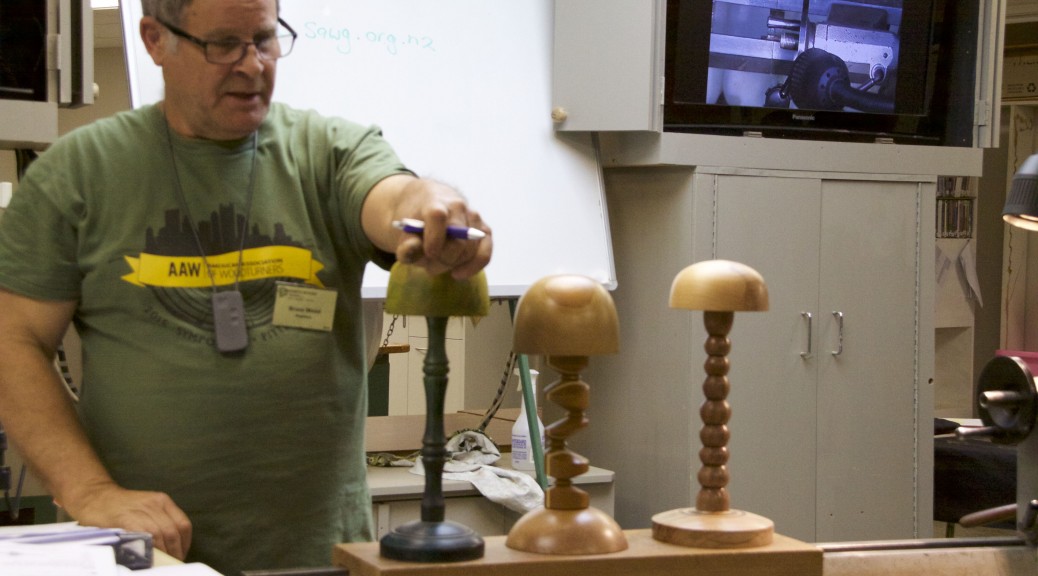Club Meeting : 14 October 2015
Report by: Terry Scott
The evening started with informative information on projects the club supports –
- Wig stands for Look Good Feel Better
- Butterfly boxes for butterfly given to parents who have lost a child through cancer
- Kidz First bowls

For those new to the club we had a run through of how the Papakura sale of woodturning works.
The evening was to be a montage of demos of items suitable for the Sale but because of the interest about the above was cut a little short.
A Plain Pen – demo by Bruce Wiseman

- Start with a blank that is at least 190 long and 20 x 20mm. It is best to hold this in a 25mm chuck but bring up a live centre for security . Or You can hold it in the centre of a larger chuck, for this make the blank longer. Round it off. Wind the speed up as this wood has a small diameter.
Bruce showed an alternative of turning a dummy Mt2 on the blank; He said this made the repetition speed up as He didn’t have to take the chuck of between stages - With the wood round, take the tailstock away. Use the dent made by the tailstock to start drilling a 3.5mm hole 130mm into the wood. Do this gently, withdrawing the drill after each 2 or 3 mm. Then drill a 4mm hole into the first 10mm of the wood. In soft wood the 3.5mm drill may have already made the start of the hole this large. Bruce held his drill bit in an old egg beater drill but said you can also make a wooden handle.
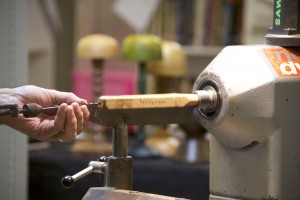
- Remove the pin from a 4mm rivet insert in the drilled hole and bring the tail up again.
This prevents the timber splitting when the timber is turned to the small size need to mate up with the refill
Now shape the pen barrel. Knobs, beads, coves, burn lines, endless possibilities.
Bruce used the Piano wire trick to add 3 black lines
Bruce said he enjoys making different shapes but prefers a bulge about a third of the way up
Continue shaping and sanding until almost ready to part off at the headstock end. Apply the finish of your choice.
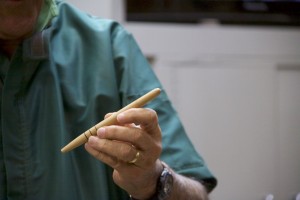
- Part off. Remove but don’t lose the pop rivet. Finish the parted off area. Insert a bic refill.
A pen like this sells for $8 to $9 depending on the character of the wood and quality of finishThanks Bruce well done
A small bowl suitable for Kidz First – demo by Colin Wise
As they say there are many ways to Skin a Cat
Because of the time frame Colin had come prepared with a blank with a spigot already turned on a 150mm cylinder blank
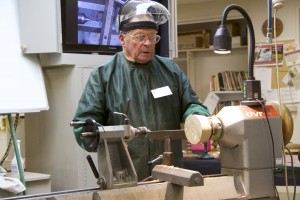
He said he normally finishes the foot which is turned to 47mm so that the 50mm jaws grip all the way around the spigot not leaving a mark,
He then proceeded to turn the back of the bowl from the headstock side ,a difficult task for many as this was turned up hill which would normally leave torn grain to die for .He had obviously perfected this method as a smooth finished that would have need little if any sanding at all
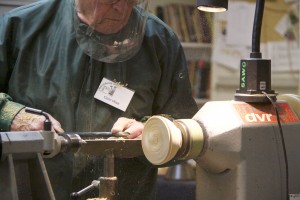
Next He cut a grove at the rim with a parting tool 3mm deep .This was so that the bevel had a shoulder to rest against and if he did have a dig in the side of the cutting tip would be pushed clear.
He used a 35 degree 13mm bowl gouge on the bevel to shape the inside of the bowl
A Teeth biting moment was then had by many in the audience as he proceeded to cut from centre out, tool upside down.
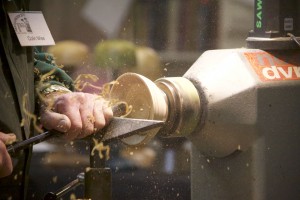
Yep you guessed it another very clean curve and finish, Sorry for doubting you Colin you sure had me sitting on the edge of my seat but be assured Ill be trying your technique on my next small bowl.
Thanks to both demonstrators that had put a lot of thought and planning into staging their respective demonstrations.
Cheers
Terry Scott
